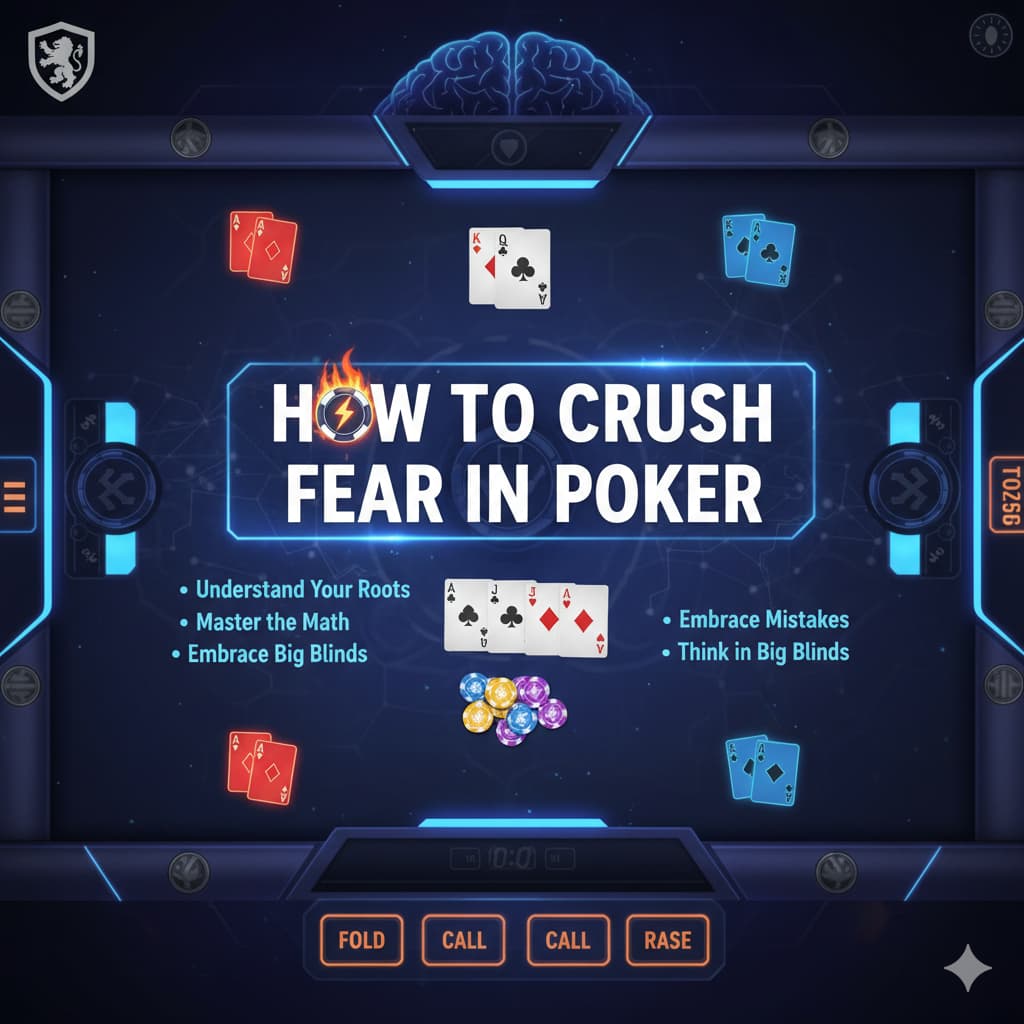Fear at the poker table can be paralyzing. It can stop you from making a crucial bluff, or keep you stuck at the same low stakes forever. But what if you could learn to control it? Crushing fear in poker is possible through a mix of understanding its roots, preparing off the table, and adopting the right mental frameworks.
Two of the biggest hurdles players face are the
fear of bluffing and the fear of moving up in stakes. Let’s break down how to conquer both and develop a winning mindset.

Understand the Roots of Your Fear
The first step to overcoming fear is understanding why it happens. Your brain isn’t trying to sabotage your poker career; it’s wired for survival.
- You’re Naturally Risk-Averse: Humans are hardwired to dislike losing. In fact, your brain remembers those painful losing sessions much more clearly than your wins, which only fuels this aversion.
- Your Opponents Are Scared, Too: This is a game-changing insight. The players you’re up against are dealing with the same fears and insecurities. They also don’t want to lose money or feel foolish. This knowledge is a weapon; you can exploit opponents who are too risk-averse to bluff or who fold too easily under pressure.
- No One Wants to Look Stupid: A deep-seated fear for many players is the embarrassment of a bluff getting called. It can feel like that nightmare of being on stage naked, and it prevents players from taking necessary, profitable risks.
How to Overcome the Fear of Bluffing
Once you understand why you feel fear, you can start building the tools to overcome it. Conquering the fear of bluffing starts long before you sit down at the table.
Do Your Off-Table Homework
This is the single most important step you can take. When your emotional brain takes over, you’ll make passive mistakes like failing to bluff. Consistent study and preparation strengthen your logical brain, giving it the power to
override the emotional response that leads to fear.
- Master the Math: Understand the break-even percentage for your bluffs. Knowing exactly how often an opponent needs to fold for your bet to be profitable turns a scary guess into a calculated, logical decision.
- Practice and Rehearse: Studying strategy is like a musician practicing scales. The more you prepare away from the table, the more confident you’ll be when it’s time to perform. It makes the game more fun and less stressful because you’re simply executing a plan you’ve already rehearsed.
Pull the Trigger
Preparation builds the foundation, but at some point, you have to act.
- Stop Overthinking and Act: While poker is a game of thought, excessive analysis can trigger panic and anxiety. Sometimes you just need to trust your preparation and “pull the trigger”.
- Embrace Mistakes: You will get called sometimes. It’s a simple fact of the game and is “baked into the math”. As long as your bluff is profitable in the long run, it’s the right play, even if it fails this one time. Don’t beat yourself up; instead, take action, study the result, and use it to improve your decisions next time.
How to Conquer the Fear of Moving Up in Stakes
The thought of bigger blinds and tougher opponents can be terrifying. But with the right mindset and practical steps, you can make the leap successfully.
Shift Your Mental Framework
The biggest battle is in your head. Winning it requires changing how you think about the money.
- Think in Big Blinds, Not Dollars: This is a powerful mental trick. Associating the money with real-world expenses like rent or food causes panic. When you reframe a $50 bet as a “10 BB bet,” you strip away that emotional baggage, making the stakes feel much less intimidating.
- Adopt a “Shot-Taking” Mentality: Don’t label yourself a “25NL player”. See yourself as a poker player who competes at a range of different limits. This mindset removes the pain of having to move down temporarily if a shot doesn’t work out.
- Treat the Money as “Gone”: For live players, a useful trick is to consider your buy-in as spent money—an “entertainment budget”. Anything you cash out at the end of the night is a bonus.
Prepare for the New Level
Mental shifts should be paired with practical preparation.
- Don’t Overhaul Your Strategy: The game at the next level probably isn’t twice as hard as you think. You’ve been winning at your current stake for a reason, so start by using the same solid strategy that got you here and adjust as you go.
- “Fish” Exist at Every Level: There are still weak players at higher stakes. While the good players are better, everyone makes mistakes.
- Simulate at Home: If you’re moving up in live poker, buy some chips and practice with the new buy-in amount at home. Cutting out bet sizes with physical chips helps reframe the money as just “chips” and “big blinds”.
- Manage Your Bankroll: A responsible “shot” involves setting aside 1-2 buy-ins for the higher stake. If you lose it, you simply move back down to rebuild without risking your entire “life-roll”. You must get comfortable with the reality that losing sessions are inevitable.
Develop a Fearless Mindset
Ultimately, crushing fear is an ongoing process of prioritizing logic and experience over emotion.
Fear is a “cheap currency” your brain loves to use, but it leads to bad decisions. The more you play and study, the more the poker table will feel like“your domain”. Use training resources to keep strengthening your logical understanding of the game. When you lose a big pot or make a mistake, don’t panic. Instead, commit to learning from it between sessions and keep moving forward.
